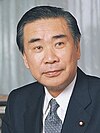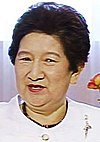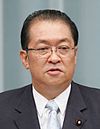Hata cabinet
| Hata cabinet | |
|---|---|
| 80th Japanese cabinet dai-80-dai naikaku |
|

|
|
|
Prime Minister Naikaku Sōri-Daijin |
Tsutomu Hata |
| Legislative period | 129. Kokkai (40th Shūgiin , 16th Sangiin ) |
| Appointed by | Emperor Akihito |
| education | April 28, 1994 |
| The End | June 30, 1994 |
| Duration | 0 years and 63 days |
| predecessor | Hosokawa cabinet |
| successor | Murayama's cabinet |
| composition | |
| Party (s) | JRP , Kōmeitō , JNP , DSP , LP , Kaikaku , DRP |
| minister | 21 (1 resignation) |
| State Secretaries | 2 parliamentary deputy heads of the Cabinet Secretariat 23 "parliamentary deputy ministers" |
| representation | |
| Shūgiin | 231/500 (April 28, 1994) |
| Sangiin | 54/252 (April 28, 1994) |
| Opposition leader | Yōhei Kōno (Shūgiin, LDP ) |
The Hata cabinet ( Japanese 羽 田 内閣 , Hata naikaku ) ruled Japan under the leadership of Prime Minister Tsutomu Hata from April 28, 1994 to June 30, 1994. After his predecessor Morihiro Hosokawa announced his resignation, Hata was deputy prime minister on April 25 elected prime minister . Even before his formal appointment, the Socialist Party of Japan (SPJ) - the largest ruling party - and the New Sakigake party announced their withdrawal from the ruling coalition that had ended the LDP government in 1993 after 38 years. The SPJ reacted to the announcement by three coalition parties that they would found a joint faction called Kaishin ( 改 新 , for example “reform” or “renewal”), which they saw as “treason”. With the exit of the SPJ, the governing coalition lost the majority in both chambers, so Hata's cabinet was a minority government tolerated by Sakigake , Shintō Mirai and the " Social Democratic League " (Shakai Minshu Renmei) . The Shinninshiki , Hata's formal appointment as prime minister, took place on the morning of April 28th. Since the other ministers in the cabinet were not appointed until the evening, Hata temporarily occupied all ministerial posts as a so-called "one-person cabinet" ( 一 人 内閣 , hitori naikaku ).
After the exit of the SPJ and Sakigake, the government coalition consisted of the Renewal Party (Shinseitō) , Kōmeitō , the New Japan Party (Nihon Shintō) , the Democratic Socialist Party (Minshatō) , the Liberal Party (Jiyūtō) , Kaikaku no Kai ("Reform Assembly") and the Minshū Kaikaku Rengō ("Democratic Reform Association"), which, as in the Hosokawa cabinet, was only represented by a parliamentary state secretary, not a minister in the cabinet.
After the passing of the budget laws for the fiscal year 1994, which began on April 1, the opposition requested a vote of no confidence in the cabinet in the Shūgiin. Given the LDP-SPJ majority against the cabinet, Hata resigned on June 25 before a vote. The SPJ (together with the New Sakigake Party) enabled the LDP to return to power in a grand coalition . The socialist Murayama Tomiichi was elected Prime Minister on June 29th and his cabinet appointed on June 30th.
Minister of State
Cabinet Secretariat, Legislative Office
| Office | Surname | Chamber of Parliament (constituency) | Political party |
|---|---|---|---|
| Deputy Head of the Cabinet Secretariat | Naoto Kitamura | Shūgiin ( Hokkaidō 5) | Renewal Party |
| Nobuo Ishihara | - | - | |
| Head of the Legislative Office | Takao Ōde | - | - |
resignation
- Justice Minister Shigeto resigned on May 8 after it in an interview with the Mainichi Shimbun , the Nanking Massacre was denied.
Web links
- Kantei , Japanese Cabinet: Hata Cabinet (Japanese)
literature
- Gerald L. Curtis: The Logic of Japanese Politics: Leaders, Institutions, and the Limits of Change. Columbia University Press, New York 1999, ISBN 0231108435 , chap. 5, p. 171 ff .: The LDP's Return to Power.







